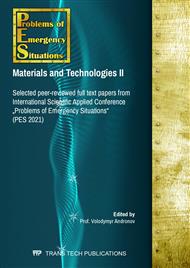[1]
V.A. Karkhin, Thermal Processes in Welding, Springer, Singapore, (2019).
Google Scholar
[2]
V. Ivanov, N.A. Makarenko, E. Lavrova, M.V. Ahieieva, Electric arc deposition of an anticorrosive layer with two strip electrodes, Solid State Phenomena. 303 (2020) 39-46.
DOI: 10.4028/www.scientific.net/ssp.303.39
Google Scholar
[3]
I. Chub, O. Pirogov, O. Mirgorod, S. Rudakov, Investigation of the Gas Sensitive Properties of Tin Dioxide Films Obtained by Magnetron Sputtering, In Materials Science Forum. Trans Tech Publications Ltd. 1006 (2020) 239-244.
DOI: 10.4028/www.scientific.net/msf.1006.239
Google Scholar
[4]
A. Pilipenko, H. Pancheva, G. Reznichenko, O. Myrgorod, N. Miroshnichenko, A. Sincheskul, The study of inhibiting structural material corrosion in water recycling systems by sodium hydroxide, Eastern-European Journal of Enterprise Technologies. 2/1 (86) (2017) 21-28.
DOI: 10.15587/1729-4061.2017.95989
Google Scholar
[5]
C.T. Kwok, S.L. Fong, F.T. Cheng, H.C. Man, Pitting and galvanic corrosion behaviour of laser-welded stainless steels, Journal of Materials Processing Technology 176 (2006) 168–178.
DOI: 10.1016/j.jmatprotec.2006.03.128
Google Scholar
[6]
N.A. Solidor, V.P. Ivanov, F.V. Morgay, B.I. Nosovsky, Investigation of corrosion resistance welds metal hose made of steels AISI 304 and AISI 316, Eastern-European Journal of Enterprise Technologies. 76 (2015) 33-39.
DOI: 10.15587/1729-4061.2015.47035
Google Scholar
[7]
Z. Tong, Z. Zhentai, Z. Rui, A dynamic welding heat source model in pulsed current gas tungsten arc welding, Journal of Materials Processing Technology. 213 (2013) 2329-2338.
DOI: 10.1016/j.jmatprotec.2013.07.007
Google Scholar
[8]
M. Mukherjee, S. Saha, T.K. Pal, P. Kanjilal, Influence of modes of metal transfer on grain structure and direction of grain growth in low nickel austenitic stainless steel weld metals, Materials Characterization. 102 (2015) 9–18.
DOI: 10.1016/j.matchar.2015.02.006
Google Scholar
[9]
P. Praveen, P.K. Yarlagadda, M.J. Kang, Advancements in pulse gas metal arc welding, Journal of Materials Processing Technology. 164/165 (2005) 1113-1119.
DOI: 10.1016/j.jmatprotec.2005.02.100
Google Scholar
[10]
Y. Song, S. Yan, T. Xiao, A study on the macro-micro physical properties in pulsed arc plasma, Transactions of JWRI. 2 (2010) 17–18.
Google Scholar
[11]
N. Karunakaran, Effect of Pulsed Current on Temperature Distribution and Characteristics of GTA Welded Magnesium Alloy, IOSR-JMCE. 4(6) (2013) 01-08.
DOI: 10.9790/1684-0460108
Google Scholar
[12]
Yu. N. Saraev, O.I. Sleptsov, V.H. Bezborodov, I.V. Nikonova and A.V. Tyutev, Effect of pulse welding on structure and properties of welds of high-strength stell pipes, Fizicheskaya mezomekhanika. 8 (2005) 141-144.
Google Scholar
[13]
V.P. Ivanov, E.V. Lavrova, Improving the efficiency of strip cladding by the control of electrode metal transfer, Applied Mechanics and Materials. 682 (2014) 266-269.
DOI: 10.4028/www.scientific.net/amm.682.266
Google Scholar
[14]
Ch.V. Pulka, O.N. Shably, V.S. Senchishin, M.V. Sharyk, G.N. Gordan, Influence of vibration of parts on structure and properties of metal in surfacing, The Paton Welding Journal. 1 (2012) 23-25.
Google Scholar
[15]
E.O. Aweda, M. Dauda, I.M. Dagwa, E.T. Dauda, Effects of continuous cooling on impact and micro structural properties of low carbon steel welded plate. IJMER. 1 (2015) 22-31.
Google Scholar
[16]
S.A. David, S.S. Babu, J.M. Vitek, Welding: solidification and microstructure, JOM. 55 (2003) 14–20.
DOI: 10.1007/s11837-003-0134-7
Google Scholar
[17]
M. Shome, O.P. Gupta, O.N. Mohanty, A modified analytical approach for modeling grain growth in the coarse grain HAZ of HSLA steels, Scripta Materialla. 50 (2004) 1007- 1010.
DOI: 10.1016/j.scriptamat.2003.12.030
Google Scholar
[18]
V. Ivanov, E. Lavrova, V. Burlaka, V. Duhanets, Calculation of the penetration zone geometric parameters at cladding with a strip electrode. Eastern-European Journal of Enterprise Technologies. 6/5 (2019) 57-62.
DOI: 10.15587/1729-4061.2019.187718
Google Scholar
[19]
S.V. Gulakov, V.V. Chigarev, V.P. Ivanov, I.S. Psareva, O.A. Lavrentik, Improvement of technology for hardfacing of metallurgical equipment components, Avtomaticheskaya Svarka. 10 (2004) 54-57.
Google Scholar


